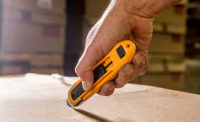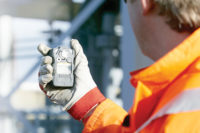Personal protective equipment (PPE) for the eyes and face is designed to prevent or lessen the severity of injuries to workers. OSHA says the employer must assess the workplace and determine if hazards that necessitate the use of eye and face protection are present or are likely to be present before assigning PPE to workers.
According to OSHA, a hazard assessment should determine the risk of exposure to eye and face hazards, including those which may be encountered in an emergency. Employers should be aware of the possibility of multiple and simultaneous hazard exposures and be prepared to protect against the highest level of each hazard.
| JUMP TO |
Following is OSHA guidance for picking PPE to protect against impact, heat, chemical, dust and optical radiation hazards to the eyes and face.
Impact Hazards
The majority of impact injuries result from flying or falling objects, or sparks striking the eye. Most of these objects are smaller than a pin head and can cause serious injury such as punctures, abrasions and contusions.
While working in a hazardous area where the worker is exposed to flying objects, fragments and particles, primary protective devices such as safety spectacles with side shields or goggles must be worn. Secondary protective devices such as face shields are required in conjunction with primary protective devices during severe exposure to impact hazards.
Heat
Heat injuries may occur to the eye and face when workers are exposed to high temperatures, splashes of molten metal, or hot sparks. Protect your eyes from heat when workplace operations involve pouring, casting, hot dipping, furnace operations and other similar activities. Burns to eye and face tissue are the main concern when working with heat hazards.
Working with heat hazards requires eye protection such as goggles or safety spectacles with special-purpose lenses and side shields. However, many heat hazard exposures require the use of a face shield in addition to safety spectacles or goggles. When selecting PPE, consider the source and intensity of the heat and the type of splashes that may occur in the workplace.
Chemicals
A large percentage of eye injuries are caused by direct contact with chemicals. These injuries often result from an inappropriate choice of PPE that allows a chemical substance to enter from around or under protective eye equipment. Serious and irreversible damage can occur when chemical substances contact the eyes in the form of splash, mists, vapors or fumes. When working with or around chemicals, it is important to know the location of emergency eyewash stations and how to access them with restricted vision.
When fitted and worn correctly, goggles protect your eyes from hazardous substances. A face shield may be required in areas where workers are exposed to severe chemical hazards.
Dust
Dust is present in the workplace during operations such as woodworking and buffing. Working in a dusty environment can causes eye injuries and presents additional hazards to contact lens wearers.
Either eyecup or cover-type safety goggles should be worn when dust is present. Safety goggles are the only effective type of eye protection from nuisance dust because they create a protective seal around the eyes.
Optical Radiation
Laser work and similar operations create intense concentrations of heat, ultraviolet, infrared and reflected light radiation. A laser beam, of sufficient power can produce intensities greater than those experienced when looking directly at the sun. Unprotected laser exposure may result in eye injuries including retinal burns, cataracts and permanent blindness. When lasers produce invisible ultraviolet or other radiation, both employees and visitors should use appropriate eye protection at all times.
Determine the maximum power density, or intensity, lasers produce when workers are exposed to laser beams. Based on this knowledge, select lenses that protect against the maximum intensity. The selection of laser protection should depend upon the lasers in use and the operating conditions. Workers with exposure to laser beams must be furnished suitable laser protection.
Lens Requirements. When selecting filter lenses, begin with a shade too dark to see the welding zone. Then try lighter shades until one allows a sufficient view of the welding zone without going below the minimum protective shade.
• 29 CFR 1910.133(a)(5) – General Industry
• 29 CFR 1915.153(a)(4) – Maritime
• 29 CFR 1926.102(b)(1) – Construction
Glare Protection. Control Glare with:
• Special-Purpose Spectacles that include filter or special-purpose lenses to provide protection against eye strain
• Changes in your work area or lighting
• Tinted eyeglass lenses or visor-type shade
For more detailed information on selecting eye and face protection for your workplace, visit www.osha.gov/SLTC/etools/eyeandface/ppe/selection.html.







